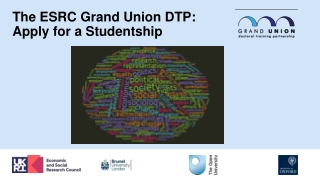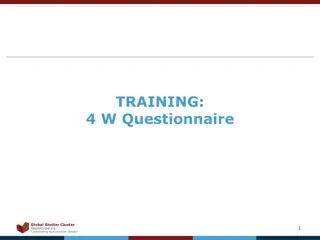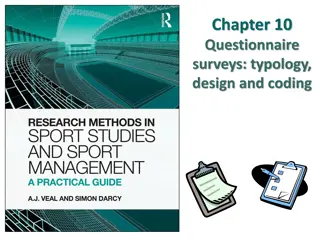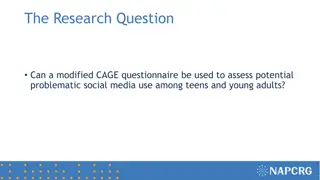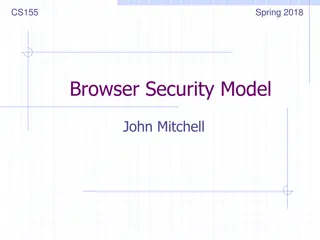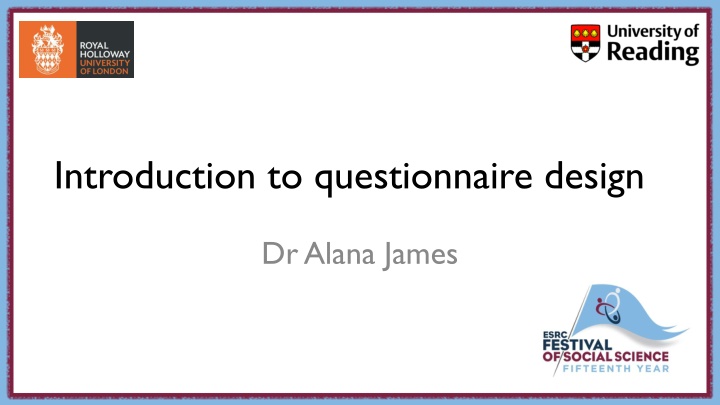
Effective Questionnaire Design Strategies for Research Success
Discover essential tips for designing effective questionnaires for research purposes. Explore various approaches, from in-person to online surveys, and learn how to structure questions, differentiate between open and closed questions, incorporate Likert scales, and more to gather valuable data for insightful analysis.
Download Presentation

Please find below an Image/Link to download the presentation.
The content on the website is provided AS IS for your information and personal use only. It may not be sold, licensed, or shared on other websites without obtaining consent from the author. If you encounter any issues during the download, it is possible that the publisher has removed the file from their server.
You are allowed to download the files provided on this website for personal or commercial use, subject to the condition that they are used lawfully. All files are the property of their respective owners.
The content on the website is provided AS IS for your information and personal use only. It may not be sold, licensed, or shared on other websites without obtaining consent from the author.
E N D
Presentation Transcript
Introduction to questionnaire design Dr Alana James
Questionnaire approaches In person Paper Online
Questionnaire approaches In person Paper Online Rank each as Low, Medium, or High for: Protecting participants anonymity Risk of researcher bias affecting responses Dependence on participants reading skills Control of the order participants answer questions in Time required for researchers to set-up and/or run
Breaking it down Sociodemographic items Background details about participants it would be useful to know Main questions Can you break these down into sections? Open question Sometimes helpful to end with open question that lets people tell you anything else which they think is important Breaking the questionnaire down can make designing it easier for researchers, and make it easier for participants to complete
Open vs. Closed questions Which do you think would most improve happiness at school? a) Free ice cream b) No exams What do you think would improve happiness at school? Useful when you Don t know much about topic Want lots of detail Answers might be harder to analyse Useful when you Want to compare certain choices Answers can be coded and may be numerically analysed
So many options Categorical questions e.g. What is your school year? Year 7 Year 8 Year 9 e.g. What clubs do you take part in? (tick all that apply) Drama club Orchestra Choir Chess club Debating society Ranking e.g. Rank these in order of importance to you (1=most important; 5=least important): Drama club Orchestra Choir Chess club Debating society e.g. Best-worst; Most-least preferred
Likert scales Items e.g. I feel happy when I am at school O Strongly Disagree O Disagree O Neither Agree nor Disagree O Agree O Strongly Agree I worry about going to school O Never O Rarely O Some of the time O Most of the time O Always Questions e.g. What do you think about the new lunch menu? O Very Poor O Poor O Neutral O Good O Very Good How do you feel about the amount of homework you receive? O Far too little O Too little O About right O Too much O Far too much
Likert scales Choose how many points in your scale Usually 3, 4, 5 or 7 To get numerical data, give each answer a score e.g. Never (0); Sometimes (1); Often (2); Always (3) Less likely (1); About the same (2); More likely (3) Not Interested (1) - - - - - - - Very Interested (7) If it makes sense, you can add up scores across questions to get a total score on a section of the questionnaire Best to keep likert scale the same across questions
Asking the right questions Avoid Complicated wording Double-barrelled questions Leading questions Double negatives Answer categories that overlap
Make it easy to complete Keep things clear Use words youngest participant can understand Use a clear font, in a size that is easy to read Don t use lots of different response scales Tell people at the start How long it will take (roughly) If some questions will be on sensitive topics That they can choose not to answer questions Help people keep track by Numbering questions and pages Thanking people at the end for taking part!
Bad questionnaire example How many issues can you spot in the questionnaire?

